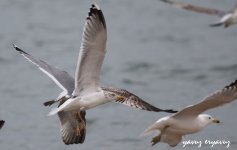kuzeycem
Medicinal Birding

Hi, today I came across a series of photographs from various birdwatchers that were labeled as "European Herring Gulls". Although most people agreed with the ID, I don't. I think this is a slightly odd Yellow-legged Gull. And here are my reasons:
1) Mantle colour is too dark, even for argentatus
2) Legs are yellow (I know omissus types can have yellow legs, but they are pretty rare aren't they?
3) The wingtip has too much black, I can clearly see black on P5.
4) P9 has a smaller mirror than typical argentatus, looks more like Herring Gull.
The only weird thing ıs the amount of head streaking, but I guess some Yellow-legged Gulls can have that much streaking.
I DO NOT OWN THESE PHOTOGRAPHS.
Thanks for your help.
1) Mantle colour is too dark, even for argentatus
2) Legs are yellow (I know omissus types can have yellow legs, but they are pretty rare aren't they?
3) The wingtip has too much black, I can clearly see black on P5.
4) P9 has a smaller mirror than typical argentatus, looks more like Herring Gull.
The only weird thing ıs the amount of head streaking, but I guess some Yellow-legged Gulls can have that much streaking.
I DO NOT OWN THESE PHOTOGRAPHS.
Thanks for your help.









